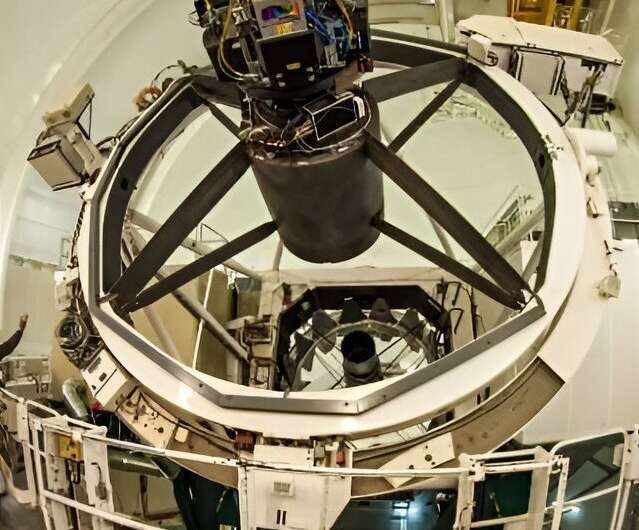
The PAUcam camera is installed at the main focus of the William Herschel Telescope (WHT) in La Palma, Spain. Credit: PAUS team
The Physics of the Accelerating Universe Survey (PAUS), an international collaboration across 14 institutions, has covered the sky of 50 square degrees, equivalent to about 250 full moons.
It can measure the length of the sky with unprecedented precision, using the specially designed PAUCam camera on the 4.2-meter William Herschel Telescope (WHT) in La Palma, Spain. This includes galaxies more than 10 billion light years away.
Surveys of distant galaxies come in two flavors: photometric surveys, which take high-resolution images of the sky and capture all the bright celestial objects to be identified in the images, and spectroscopic analysis, which focuses on the known light source and studies it. spectrum, i.e. the distribution of its light over several wavelengths.
This mode is not limited to how many galaxies can be seen, and how tiring, but provides a wealth of information about each galaxy.
Collaboration member Professor Benjamin Joachimi, of the UCL Department of Physics & Astronomy, explained that PAUS “combines the advantages of photometric and spectroscopic analysis.”
“We take pictures and capture everything visible in the sky, but do it by putting a long-wavelength filter on the camera so we know that the light we’re collecting is coming from some part of the sky,” he said. By using such a filter, we can reconstruct the lower version of the galaxy.
“This research will help us to find out how the galaxies are connected to their environment, which is usually dark matter, and to understand how galaxies of the same type and brightness are far away, which helps us to do science well and research that doesn’t have this information.”
The new catalog will help astronomers create accurate maps to understand how processes develop in the universe and study the expansion of the universe under the influence of dark matter and dark energy.
Dark energy is thought to make up about 70% of the universe and is responsible for the expansion of the universe, but its nature remains a mystery.
The collaboration is led by the Institute of Space Sciences (ICE-CSIC), sponsored by the Ministry of Science, Innovation and the University of Spain. The data was collected over 200 nights between 2015 and 2019. The catalog is available on the PAUS website and the CosmoHub web portal.
Professor Enrique Gaztañaga, head of research at PAU based at the University of Portsmouth, ICE-CSIC and the Institute of Space Studies of Catalonia (IEEC), said, “PAU’s research offers a unique way to create space maps, made through the design and development of a journal and research dedicated to collecting and analyzing data in an unprecedented way.
The catalog release is divided into two articles. Group and organization of PAUS data is published in Monthly Bulletin of the Royal Astronomical Society. The other, in equal measure, is accepted for publication by MNRAS and available at arXiv preprint server.
David Navarro-Gironés, Ph.D. student at ICE-CSIC and first author of arXiv book, said, “The great thing about PAUS is that it…[allows] for a very good equation. This level of precision is critical for studying the structure of the universe, which in turn requires data from a large number of galaxies.
Nine years after its first flare in 2015, PAUS can measure the size of many distant galaxies with a precision of 0.3%. The team is now using this data to improve the design of existing space probes.
For example, PAUS data is used to improve weak lensing analysis and simulations for dark energy projects such as the European Space Agency’s Euclid mission, led by an international team of UCL researchers, and the Rubin Observatory’s Legacy Survey of Space and Time (LSST).
Other information:
FJ Castander et al, PAU analysis: photometric analysis of narrow band images, Monthly Bulletin of the Royal Astronomical Society (2024). DOI: 10.1093/mnras/stae1507
David Navarro-Gironés et al, PAU Review: Photometric redshift measurements in the deep field, Monthly Bulletin of the Royal Astronomical Society (2024). DOI: 10.1093/mnras/stae1686. Turn on arXiv: DOI: 10.48550/arxiv.2312.07581
It was awarded by University College London
References: Precise locations of over a million galaxies revealed (2024, September 28) Retrieved 29 September 2024 from https://phys.org/news/2024-09-precise-million-galaxies-revealed.html
This document is subject to copyright. Except for any legitimate practice for study or personal research purposes, no part may be reproduced without written permission. This content is provided for informational purposes only.
#exact #locations #million #galaxies #revealed